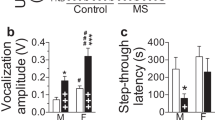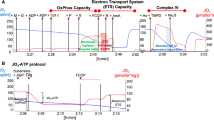Abstract
The hypothalamic–pituitary–adrenal axis is a pivotal component of an organism's response to stressful challenges, and dysfunction of this neuroendocrine axis is associated with a variety of physiological and psychological pathologies. We found that corticotropin-releasing factor type 1 receptor within the paraventricular nucleus of the hypothalamus is an important central component of hypothalamic–pituitary–adrenal axis regulation that prepares the organism for successive exposure to stressful stimuli.
This is a preview of subscription content, access via your institution
Access options
Access Nature and 54 other Nature Portfolio journals
Get Nature+, our best-value online-access subscription
$29.99 / 30 days
cancel any time
Subscribe to this journal
Receive 12 print issues and online access
$209.00 per year
only $17.42 per issue
Buy this article
- Purchase on Springer Link
- Instant access to full article PDF
Prices may be subject to local taxes which are calculated during checkout



Similar content being viewed by others
References
Ulrich-Lai, Y.M. & Herman, J.P. Nat. Rev. Neurosci. 10, 397–409 (2009).
Raison, C.L. & Miller, A.H. Am. J. Psychiatry 160, 1554–1565 (2003).
de Kloet, C.S. et al. J. Psychiatr. Res. 40, 550–567 (2006).
Vale, W., Spiess, J., Rivier, C. & Rivier, J. Science 213, 1394–1397 (1981).
Rivier, C. & Vale, W. Nature 305, 325–327 (1983).
Dallman, M.F., Akana, S.F., Bhatnagar, S., Bell, M.E. & Strack, A.M. Int. J. Obes. 24 (Suppl. 2), S40–S46 (2000).
De Kloet, E.R., Vreugdenhil, E., Oitzl, M.S. & Joëls, M. Endocr. Rev. 19, 269–301 (1998).
Chen, R., Lewis, K.A., Perrin, M.H. & Vale, W.W. Proc. Natl. Acad. Sci. USA 90, 8967–8971 (1993).
Lovenberg, T.W. et al. Proc. Natl. Acad. Sci. USA 92, 836–840 (1995).
Justice, N.J., Yuan, Z.F., Sawchenko, P.E. & Vale, W. J. Comp. Neurol. 511, 479–496 (2008).
Van Pett, K. et al. J. Comp. Neurol. 428, 191–212 (2000).
Henckens, M.J.A.G., Deussing, J.M. & Chen, A. Nat. Rev. Neurosci. 17, 636–651 (2016).
Refojo, D. et al. Science 333, 1903–1907 (2011).
Gulyas, J. et al. Proc. Natl. Acad. Sci. USA 92, 10575–10579 (1995).
Taniguchi, H. et al. Neuron 71, 995–1013 (2011).
Smith, G.W. et al. Neuron 20, 1093–1102 (1998).
Balthasar, N. et al. Cell 123, 493–505 (2005).
Madisen, L. et al. Nat. Neurosci. 13, 133–140 (2010).
Krishnan, V. et al. Cell 131, 391–404 (2007).
Wang, S.-S., Kamphuis, W., Huitinga, I., Zhou, J.-N. & Swaab, D.F. Mol. Psychiatry 13, 786–799, 741 (2008).
Henckens, M.J.A.G. et al. Mol. Psychiatry http://www.nature.com/mp/journal/vaop/ncurrent/full/mp2016133a.html (2016).
Acknowledgements
We thank N. Nevo for assistance with the adrenalectomy procedure. We thank S. Ovadia and Y. Madar for their devoted assistance with animal care. We thank J. Keverne for professional English editing, formatting and scientific input. A.C. is supported by the Max Planck Society and the Weizmann Institute of Science. This work was supported by an FP7 grant from the European Research Council (260463); a research grant from the Israel Science Foundation (1565/15); research support from Roberto and Renata Ruhman; Bruno and Simone Licht; the Nella and Leon Benoziyo Center for Neurological Diseases; the Henry Chanoch Krenter Institute for Biomedical Imaging and Genomics; the Perlman Family Foundation, founded by Louis L. and Anita M. Perlman; the Adelis Foundation and the Irving I. Moskowitz Foundation; the I-CORE Program of the Planning and Budgeting Committee; and the Israel Science Foundation (grant No 1916/12). Y.K. is supported by Sarah and Rolando Uziel.
Author information
Authors and Affiliations
Contributions
A.R. designed and performed most of the experiments. Z.J., J.-B.T. and N.J. designed and performed electrophysiological studies. Z.J. and N.J. performed the single-cell reverse-transcription-PCR. Y.K. and T.N. assisted in experiments. A.R., N.J. and A.C. conceived, designed and supervised the project. A.R., N.J. and A.C. wrote the manuscript.
Corresponding authors
Ethics declarations
Competing interests
The authors declare no competing financial interests.
Integrated supplementary information
Supplementary Figure 1 PVN CRFR1+ neurons represent a distinct population of neurons residing in the PVN.
(a). PVN-CRFR1+ neurons are significantly smaller in size than OT+ and AVP+ neurons. Volumetric measurements revealed significant differences in somatal-volume between PVN-CRFR1+ neurons and OT+ and AVP+ neurons (One-way ANOVA, F(3,521)=84.3, p<0.001 followed by Tukey’s post-hoc analysis). Data presented as mean ± SEM, n=5 mice. (b) Brain coronal sections obtained from CRFCre x CRFR1GFP mice following injection of DIO-mCherry virus reveal PVN-CRF+ fibers adjacent to PVN-CRFR1-GFP+ neurons. Magnification at 40X. Scale bar represents 10 μm (c) Representative image showing single-cell reverse-transcription-PCR products of 5 PVN neurons positive for CRFR1-GFP. Amplification of Gapdh mRNA served as an internal positive control and data was only included when there was Gapdh positive signal. Eleven out of 12 PVN-CRFR1+ neurons express mRNA for Gad1 or Gad2, the GABA synthesizing enzymes.
Supplementary Figure 2 CRFR1 levels outside the PVN are not regulated by GCs.
Brain coronal sections obtained from CRFR1GFP:ADX mice, immuno-stained for GFP 24 hours following treatment with saline or DEX, revealed that CRFR1GFP:ADX mice treated with DEX show similar GFP expression as CRFR1GFP:ADX treated with saline in the cortex, reticular thalamic nucleus (RT) and central nucleus of the amygdala (CeA) [t(2)=0.1, n.s; t(2)=0.07, n.s and t(2)=-1.11, n.s, respectively, n=4 mice]. Data presented as mean ± SEM.
Supplementary Figure 3 PVN CRFR1-GFP+ neurons coexpress GRs
(a) Brain coronal sections obtained from CRFR1GFP mice immuno-stained for glucocorticoid receptor (GR). (b) Summary of colocalized PVN-CRFR1-GFP+ neurons with GR showing 97% PVN-CRFR1-GFP+ neurons co-express GR (n=3 mice, each data point represents 1 PVN slice). Magnification at 20X. Scale bar represents 100 μm. Data presented as mean ± SEM. (c) Summary of colocalization of Sim1-cre and CRFR1-GFP+ neurons within the medial amygdala nucleus (MeA; a brain region known to express both Sim117 and CRFR111) showing 5% of MeA-CRFR1-GFP+ neurons co-express Cre (visualized by lox-stop-lox-mCherry). n=2 mice, each data point represents 1 brain slice.
Supplementary Figure 4 CRFR1PVN-cKO mice and control mice display similar plasma CORT levels following acute stressors.
CRFR1PVN-cKO mice and control mice display similar plasma CORT levels following acute stressors. CORT radioimmunoassay was performed in order to measure the circulating CORT levels, following exposure to restraint stress (a), hemorrhage (b), LPS injection (c) and DEX suppression test in which blood was collected 4 hrs after DEX administration (1 μg/10 g BW i.p.) (d). CRFR1PVN-cKO mice did not differ from control mice in any of the tests [based on repeated measure ANOVA (a; F(1,10)=0.28, n.s. b; F(1,15)=0.11, n.s. and c; F(1,12)=1.13, n.s.) and independent sample t-tests (d; t(10)=-1.32, n.s. and t(10)=-0.97, n.s.) before and after DEX administration, respectively. n=11 control mice and 9 CRFR1PVN-cKO mice (a), n=9 mice (b), n=8 (c) and n=7 control mice and 5 CRFR1PVN-cKO mice (d)]. Data presented as mean ± SEM.
Supplementary Figure 5 No difference was observed between CRFR1PVN-cKO mice and controls in social avoidance following chronic social defeat stress.
Interaction ratio was calculated as time spent in the zone near the non-familiar mouse divided by the time spent in the same zone during habitation (duration; t(19)=-0.41, n.s.) and as the number of entries to the zone near the non-familiar mouse divided by the number of entries to the same zone during habitation (frequency; t(19)=0.82, n.s.). Data presented as mean ± SEM. n=10 (control) and 11 (CRFR1PVN-cKO) mice per group.
Supplementary Figure 6 CRFR1PVN-cKO mice showed no differences in anxiety-like behaviors compared to control mice as indicated in the open field test.
No differences between CRFR1PVN-cKO mice and controls in time spent in the center of the arena (a; t(14)=0.99, n.s) and distance traveled in the border of the arena (b; t(14)=1.36, n.s), center of the arena (t(14)=0.99, n.s) or total distance (t(14)=1.34, n.s). n=7 (control) 9 (CRFR1PVN-cKO) mice per group. Data presented as mean ± SEM.
Supplementary Figure 7 CRFR1PVN-cKO mice are less active then control mice.
(a) Home cage locomotion was assessed for mice placed individually and their locomotion is presented hourly for 72 hrs. (b) Summary of the data. Compared to control mice, CRFR1PVN-cKO mice are less active during the dark phase (t(18)=2, p=0.06) and during the light phase (t(18)=2.45, p=0.024). Data presented as means ± SEM. n=10 mice per group. (c,d) CRFR1PVN-cKO mice are less active following chronic stress. (c) Home cage locomotion was assessed for mice placed individually and their locomotion is presented hourly for 72 hrs. (d) Quantification of the data. Compared to control mice, CRFR1PVN-cKO mice are less active during the dark phase (t(11)=2.40, p=0.035) but not during the light phase (t(17)=1.0, n.s). Data presented as mean ± SEM. n=10 (control) and 9 (CRFR1PVN-cKO) mice per group.
Supplementary Figure 8 Potential mechanism
(a) PVN-CRFR1 levels are positively-regulated by GCs. In contrast to PVN CRF expression, which is up-regulated in low GC conditions and down-regulated in high GC conditions, PVN-CRFR1 levels are down-regulated by low levels of GCs and up-regulated by high levels of GCs. (b) PVN-CRFR1+ neurons are “recruited” specifically in chronic stress conditions. PVN-CRFR1+ neurons are more active under chronic stress conditions than under acute stress conditions.
Supplementary information
Supplementary Text and Figures
Supplementary Figures 1–8 and Supplementary Table 1 (PDF 1218 kb)
PVN-CRFR1+ neurons
Brain slice taken from CRFCre x Ai9 x CRFR1GFP mouse showing PVN-CRFR1+ neurons (in green) adjacent to PVN-CRF+ neurons (in red). (MOV 5159 kb)
PVN-CRF+ neurons projects to nearby CRFR1+ cells
Brain slice obtained from CRFCre x CRFR1GFP mice following injected with DIO-mCherry virus into the PVN. (MOV 10755 kb)
Rights and permissions
About this article
Cite this article
Ramot, A., Jiang, Z., Tian, JB. et al. Hypothalamic CRFR1 is essential for HPA axis regulation following chronic stress. Nat Neurosci 20, 385–388 (2017). https://doi.org/10.1038/nn.4491
Received:
Accepted:
Published:
Issue Date:
DOI: https://doi.org/10.1038/nn.4491
This article is cited by
-
Nuclei-specific hypothalamus networks predict a dimensional marker of stress in humans
Nature Communications (2024)
-
Alternative splicing in mouse brains affected by psychological stress is enriched in the signaling, neural transmission and blood-brain barrier pathways
Molecular Psychiatry (2023)
-
Hypothalamic CRH neurons represent physiological memory of positive and negative experience
Nature Communications (2023)
-
SIRT1 in the BNST modulates chronic stress-induced anxiety of male mice via FKBP5 and corticotropin-releasing factor signaling
Molecular Psychiatry (2023)
-
Superior control of inflammatory pain by corticotropin-releasing factor receptor 1 via opioid peptides in distinct pain-relevant brain areas
Journal of Neuroinflammation (2022)



